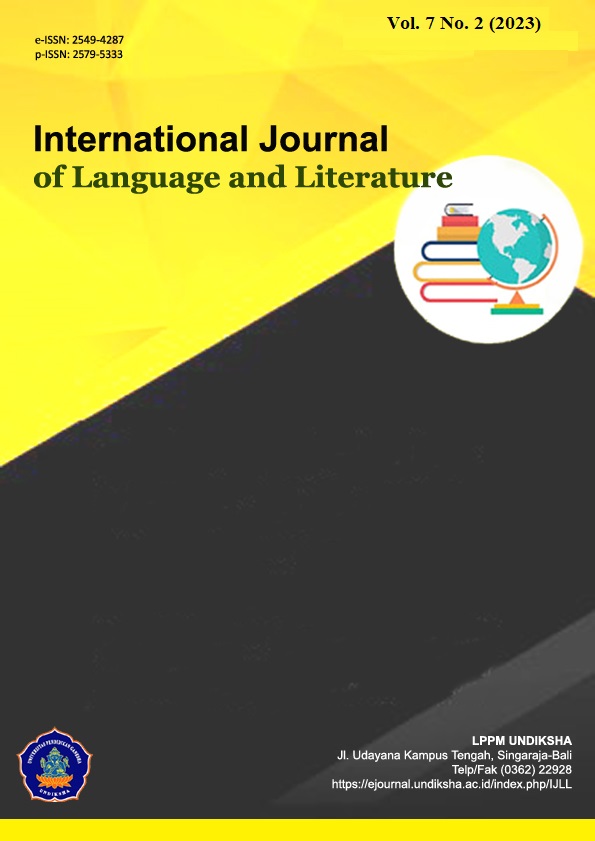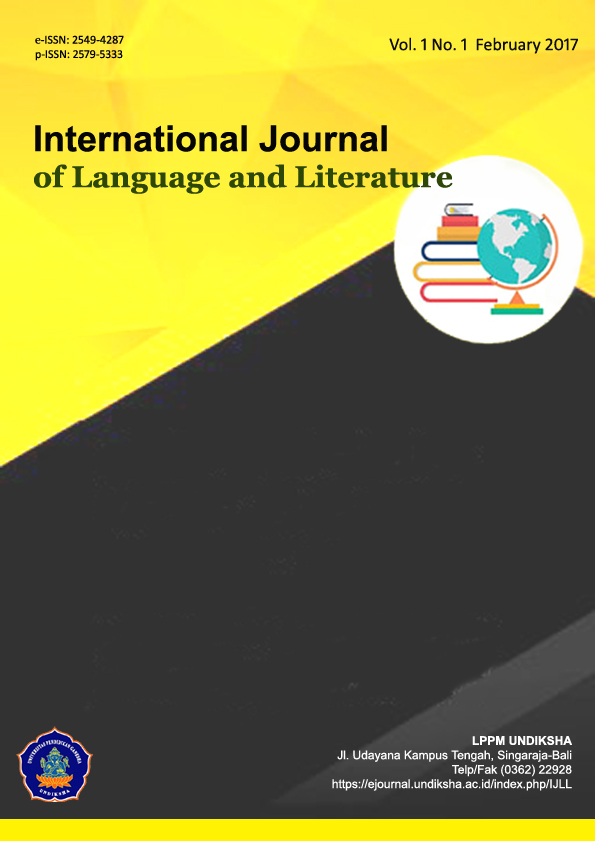A Sociolinguistics Analysis of Stereotypes in the Freedom Writers Movie
DOI:
https://doi.org/10.23887/ijll.v7i2.41111Keywords:
Sociolinguistics, Stereotypes, Freedom Writers MovieAbstract
Stereotypes are viewed negatively since they indicate negative preconceptions about others. Hence, stereotypes are important to study because people might unknowingly employ stereotypes about others in regular encounters. Stereotypes are also found in many films, one of which is in the film "Freedom writer." The aims of this study are to analyze the categories of stereotypes that existed in the film Freedom Writer and to identify the functions of the stereotypes that are produced in the film. The researcher uses descriptive qualitative research. This research is a sociolinguistic approach of stereotypes occurring in the movie entitled Freedom Writers. The data is all utterances in the movie. The data analysis technique is carried out by employing sociolinguistics theory. The results of this study show that there are three categories of stereotypes occur: gender, race, and physical traits. The characters in Freedom Writers represent a diverse range of races, and their frequent interactions enable them to readily observe the different characteristics associated with their respective races. Consequently, due to the film's setting in a multicultural society, various stereotypes regarding race, with a particular emphasis on conflicts related to skin color, are prevalent. These stereotypes are influenced by cultural factors within this context.
References
Abunab, H. Y., Dator, W. L. T., Salvador, J. T., & Lacanaria, M. G. C. (2017). Solitude, Religious and Cultural Uniqueness in a Foreign Environment: Adjustments as an Arab Student. Journal of Religion and Health, 56(5), 1701–1718. https://doi.org/10.1007/s10943-017-0425-x. DOI: https://doi.org/10.1007/s10943-017-0425-x
Bobbitt-Zeher, D. (2011). Gender discrimination at work: Connecting gender stereotypes, institutional policies, and gender composition of workplace. Gender & Society, 25(6), 764–786. https://doi.org/10.1177/0891243211424741. DOI: https://doi.org/10.1177/0891243211424741
Centeno, R. (2020). Effect of mindfulness on empathy and self-compassion: An adapted MBCT Program on Filipino college students. Behavioral Sciences (Basel, Switzerland), 10(3), 61. https://doi.org/10.3390/bs10030061. DOI: https://doi.org/10.3390/bs10030061
Duguid, M. M., & Thomas-Hunt, M. C. (2015). Condoning stereotyping? How awareness of stereotyping prevalence impacts expression of stereotypes. ,. Journal of Applied Psychology, 100(2), 343. https://doi.org/10.1037/a0037908. DOI: https://doi.org/10.1037/a0037908
Ellis, J. M., Rowley, L. L., Nellum, C. J., & Smith, C. D. (2018). From alienation to efficacy: An examination of racial identity and racial academic stereotypes among Black male adolescents. Urban Education, 53(7), 899–928. https://doi.org/10.1177/0042085915602538. DOI: https://doi.org/10.1177/0042085915602538
Fitriani, M. (2017). A Sociolinguistic Analysis Of Stereotypes In Freedom Writers Movie. Sastra Inggris-Quill, 6(8), 780–786. https://journal.student.uny.ac.id/index.php/quill/article/view/9504.
FitzGerald, C., Martin, A., Berner, D., & Hurst, S. (2019). Interventions designed to reduce implicit prejudices and implicit stereotypes in real world contexts: a systematic review. BMC Psychology, 7(1), 1–12. https://doi.org/10.1186/s40359-019-0299-7. DOI: https://doi.org/10.1186/s40359-019-0299-7
Hasbi, M. (2013). The attitudes of students from ESL and EFL countries to English. Register Journal, 6(1), 1–16. https://doi.org/10.18326/rgt.v6i1.1-16. DOI: https://doi.org/10.18326/rgt.v6i1.1-16
Hidayati, N. (2017). Appraisal analysis in freedom writers movie. EduLite: Journal of English Education, Literature and Culture, 2(1), 317–333. https://doi.org/10.30659/e.2.1.317-333. DOI: https://doi.org/10.30659/e.2.1.317-333
Jahanbakhsh, A. A., AliAsgariZamani, M., & Garman, Z. (2019). CIRC and STAD in Iranian context: Through the five elements to cooperative learning of lexical collocations. Cogent Arts and Humanities, 6(1). https://doi.org/10.1080/23311983.2019.1692469. DOI: https://doi.org/10.1080/23311983.2019.1692469
Kanoksilapatham, B., & Suranakkharin, T. (2018). Celebrating Local, Going Global : Use of Northern Thainess-Based English Lessons. The Journal of AsiaTEFL, 15(2), 292–309. https://doi.org/10.18823/asiatefl.2018.15.2.3.292. DOI: https://doi.org/10.18823/asiatefl.2018.15.2.3.292
Kecskes, I. (2021). Processing implicatures in English as a Lingua Franca communication. Lingua, 256, 103067. https://doi.org/10.1016/j.lingua.2021.103067. DOI: https://doi.org/10.1016/j.lingua.2021.103067
Knauer, H. A., Jakiela, P., Ozier, O., Aboud, F., & Fernald, L. C. H. (2020). Enhancing young children’s language acquisition through parent–child book-sharing: A randomized trial in rural Kenya. Early Childhood Research Quarterly, 50, 179–190. https://doi.org/10.1016/j.ecresq.2019.01.002. DOI: https://doi.org/10.1016/j.ecresq.2019.01.002
Koedel, C., Li, J., Springer, M. G., & Tan, L. (2017). The Impact of Performance Ratings on Job Satisfaction for Public School Teachers. American Educational Research Journal, 54(2), 241–278. https://doi.org/10.3102/0002831216687531. DOI: https://doi.org/10.3102/0002831216687531
Lai, C. (2019). Learning beliefs and autonomous language learning with technology beyond the classroom. Language Awareness, 28(4). https://doi.org/10.1080/09658416.2019.1675679. DOI: https://doi.org/10.1080/09658416.2019.1675679
Lambert, V. A., & Lambert, C. E. (2012). Qualitative Descriptive Research: An Acceptable Design. Pacific Rim International Journal of Nursing Research, 16(4), 255–256. http://antispam.kmutt.ac.th/index.php/PRIJNR/article/download/5805/5064.
Lindvall-Östling, M., Deutschmann, M., & Steinvall, A. (2020). An exploratory study on linguistic gender stereotypes and their effects on perception. Open Linguistics, 5(1), 567–583. https://doi.org/10.1515/opli-2020-0033. DOI: https://doi.org/10.1515/opli-2020-0033
McGlone, M. S., & Pfiester, R. A. (2015). Stereotype threat and the evaluative context of communication. Journal of Language and Social Psychology, 34(2), 111–137. https://doi.org/10.1177/0261927X14562609. DOI: https://doi.org/10.1177/0261927X14562609
Mello, S., Tan, A. S., Sanders-Jackson, A., & Bigman, C. A. (2019). Gender stereotypes and preconception health: Men’s and Women’s expectations of responsibility and intentions to engage in preventive behaviors. Maternal and Child Health Journal, 23, 459–469. https://doi.org/10.1007/s10995-018-2654-3. DOI: https://doi.org/10.1007/s10995-018-2654-3
Nassar, H. (2021). Reasons behind mis/understanding English conversational implicatures by University learners in Yemen. Studies in Pragmatics and Discourse Analysis, 2(1), 40–55. https://doi.org/10.48185/spda.v2i1.291. DOI: https://doi.org/10.48185/spda.v2i1.291
Nur’aini, A. B., Triana, J., & Fogli, L. (2021). The Analysis of Word Formation in Movie “Wonder” and Its Application in Teaching Vocabulary. Scripta : English Department Journal, 8(2), 20–27. https://doi.org/10.37729/scripta.v8i2.702. DOI: https://doi.org/10.37729/scripta.v8i2.702
Oktaviani, Y., & Arimbi, D. A. (2015). The Representation of Female Lead Characters (Ravenna and Snow White) in Snow White and the Huntsman Film. Allusion, 4(2), 54–76. https://repository.unair.ac.id/117594.
Razavi, M., & Gilakjani, A. P. (2020). The effect of teaching cultural content on intermediate EFL learners’ reading comprehension ability. Teflin Journal, 31(2), 302–321. https://doi.org/10.15639/teflinjournal.v31i2/302-321. DOI: https://doi.org/10.15639/teflinjournal.v31i2/302-321
Rice, D. R. (2021). Against Such Things There is No Law: Evangelical College Students’ Perceptions of the Fruit of the Spirit as Primarily Gendered. Journal of Psychology and Theology, 49(1), 38–52. https://doi.org/10.1177/0091647120907984. DOI: https://doi.org/10.1177/0091647120907984
Rifai, D. M., & Prasetyaningrum, S. T. (2016). A Sociolinguistic Analysis of Addressing Terms Used in Tangled Movie Manuscript. Jurnal Penelitian Humaniora, 17(2), 123–134. https://doi.org/10.23917/humaniora.v17i2.2504. DOI: https://doi.org/10.23917/humaniora.v17i2.2504
Salifu, N. A. (2010). Signaling Politeness, Power and Solidarity through Terms of Address in Dagbanli. Nordic Journal of African Studies, 19(4), 274–292. https://doi.org/10.53228/njas.v19i4.198.
Silaban, H. S., & Afriana, A. (2020). Address Form Analysis in the Movie “Mortdecai.” Linguistic, English Education and Art (LEEA) Journal, 4(1), 25–33. https://doi.org/10.31539/leea.v4i1.1391. DOI: https://doi.org/10.31539/leea.v4i1.1391
Stevenson, H. (2014). Moving away from stereotypes and preconceptions: Students and their education in East Asia and the United States. In Cross-Cultural Roots of Minority Child Development, 313–319. https://www.taylorfrancis.com/chapters/edit/10.4324/9781315746555-18. DOI: https://doi.org/10.4324/9781315746555-18
Torres, F., Fuentes-López, E., Fuente, A., & Sevilla, F. (2020). Identification of the factors associated with the severity of the speech production problems in children with comorbid speech sound disorder and developmental language disorder. Journal of Communication Disorders, 88(June 2019). https://doi.org/10.1016/j.jcomdis.2020.106054. DOI: https://doi.org/10.1016/j.jcomdis.2020.106054
Vaismoradi, M., Jones, J., Turunen, H., & Snelgrove, S. (2016). Theme development in qualitative content analysis and thematic analysis. Journal of Nursing Education and Practice, 6(5). https://doi.org/10.5430/jnep.v6n5p100. DOI: https://doi.org/10.5430/jnep.v6n5p100
Windels, K. (2016). Stereotypical or just typical: how do US practitioners view the role and function of gender stereotypes in advertisements? International Journal of Advertising, 35(5), 864–887. https://doi.org/10.1080/02650487.2016.1160855. DOI: https://doi.org/10.1080/02650487.2016.1160855
Downloads
Published
How to Cite
Issue
Section
License
Copyright (c) 2023 International Journal of Language and Literature

This work is licensed under a Creative Commons Attribution-ShareAlike 4.0 International License.
IJLL Journal provides immediate open access to its content on the principle that making research freely available to the public to supports a greater global exchange of knowledge.

This work is licensed under a Creative Commons Attribution-ShareAlike 4.0 International License








